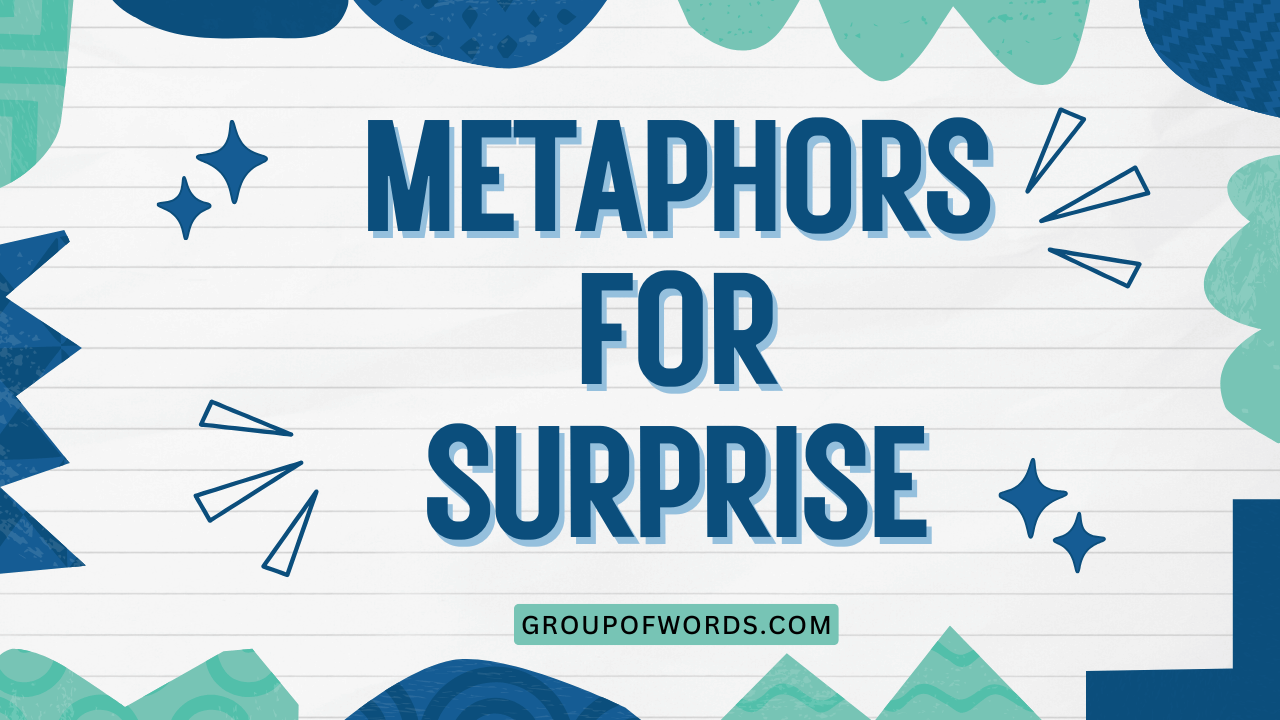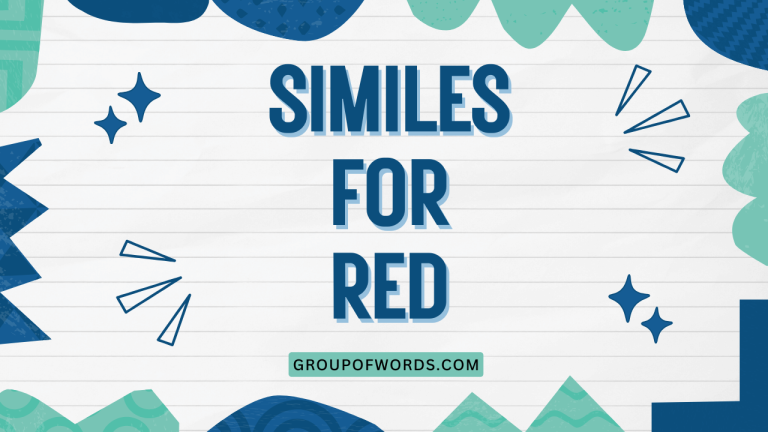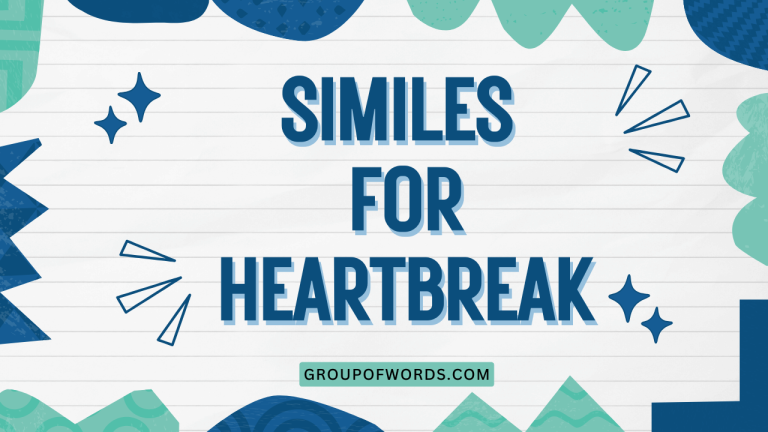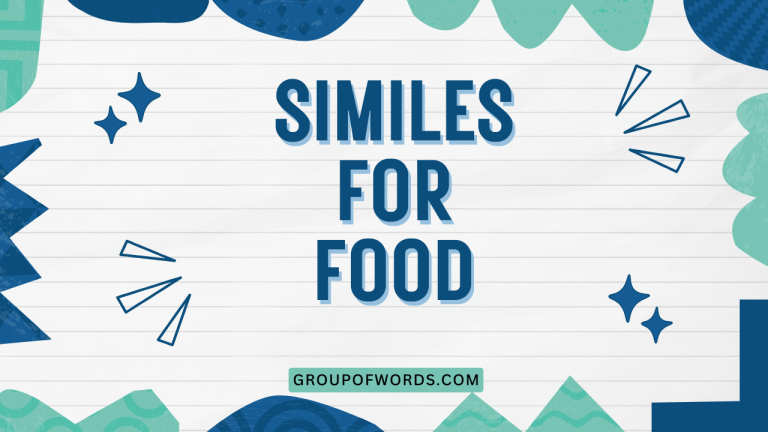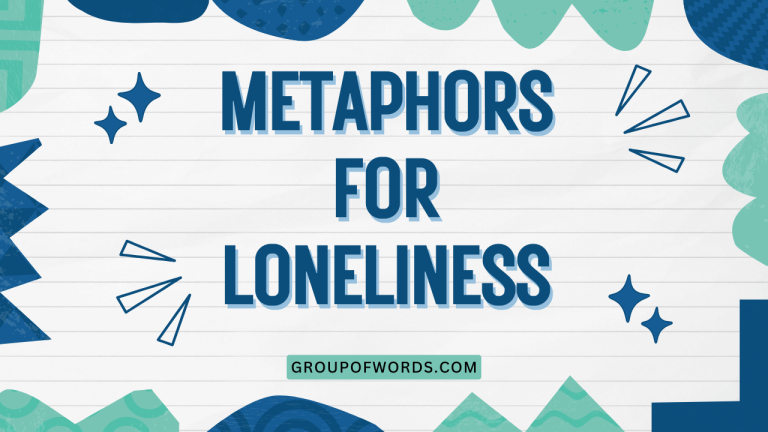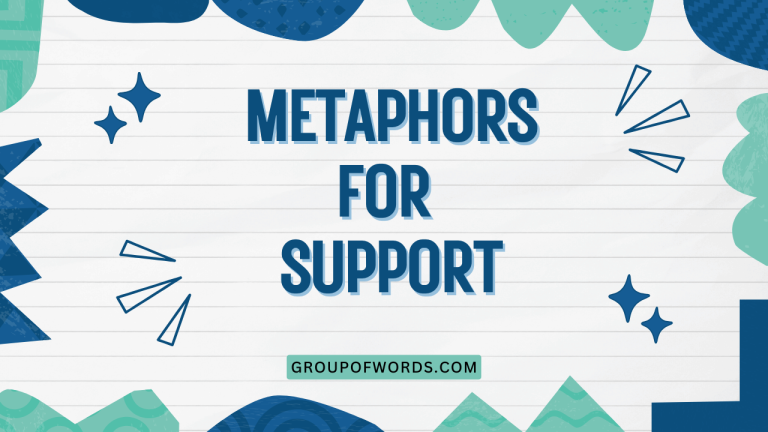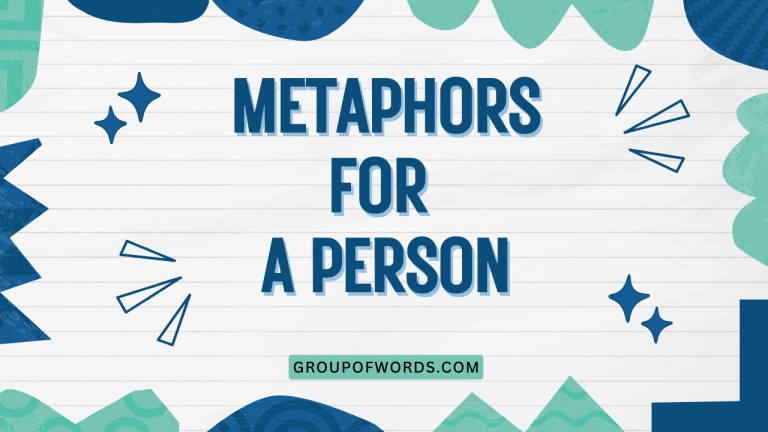Metaphors for Surprise: A Comprehensive Guide
Surprise is a fundamental human emotion, and English offers a rich tapestry of metaphors to express its various nuances. Understanding these metaphors not only enhances your vocabulary but also deepens your comprehension of figurative language.
This article provides a comprehensive exploration of metaphors for surprise, covering their definitions, structural elements, categories, usage rules, and common mistakes. Whether you’re an ESL learner, a student of linguistics, or simply someone who enjoys exploring the intricacies of language, this guide will equip you with the knowledge to effectively use and interpret metaphors for surprise.
This guide is designed to be accessible to learners of all levels, breaking down complex concepts into manageable segments with numerous examples and practice exercises. By the end of this article, you’ll be able to identify, understand, and use metaphors for surprise with confidence.
Table of Contents
- Introduction
- Definition of Metaphor for Surprise
- Structural Breakdown
- Types and Categories of Metaphors for Surprise
- Examples of Metaphors for Surprise
- Usage Rules for Metaphors of Surprise
- Common Mistakes with Metaphors for Surprise
- Practice Exercises
- Advanced Topics
- FAQ
- Conclusion
Definition of Metaphor for Surprise
A metaphor for surprise is a figure of speech that describes the feeling of surprise by comparing it to something else that shares similar characteristics. Unlike similes, which use “like” or “as” to make a comparison, metaphors directly equate surprise with another concept.
The function of these metaphors is to add vividness, emotional depth, and imaginative appeal to descriptions of surprise. They allow speakers and writers to convey the intensity and nature of surprise in a more engaging and relatable way.
Metaphors for surprise can be classified based on the type of imagery they evoke. For example, some metaphors use physical impact to describe surprise, while others rely on light and darkness.
The context in which these metaphors are used can also vary widely, ranging from casual conversations to formal literature. The choice of metaphor depends on the specific nuance of surprise that the speaker or writer wishes to convey.
Structural Breakdown
Metaphors for surprise, like all metaphors, consist of two key elements: the tenor and the vehicle. The tenor is the subject being described (in this case, surprise), and the vehicle is the object or concept to which it is being compared. The connection between the tenor and vehicle is based on shared characteristics or associations.
Consider the metaphor “The news hit me like a ton of bricks.” Here, the tenor is the feeling of surprise caused by the news, and the vehicle is “a ton of bricks.” The shared characteristic is the feeling of sudden, overwhelming impact. Understanding this structure allows you to deconstruct and interpret different metaphors for surprise more effectively. The effectiveness of a metaphor lies in the strength of the connection between the tenor and the vehicle, and how vividly it conveys the intended meaning.
Types and Categories of Metaphors for Surprise
Metaphors for surprise can be categorized based on the type of imagery they evoke. Here are some common categories:
Physical Impact Metaphors
These metaphors describe surprise in terms of physical force or impact. They often convey a sense of shock, disorientation, or being overwhelmed.
Examples include “hit me like a ton of bricks,” “knocked me off my feet,” and “took my breath away.”
Light and Darkness Metaphors
These metaphors use the imagery of light and darkness to describe surprise. Light often represents clarity and revelation, while darkness can symbolize confusion or being overwhelmed.
Examples include “it dawned on me,” “blindsided,” and “left me in the dark.”
Size and Scale Metaphors
These metaphors use the concept of size and scale to convey the magnitude of surprise. They can suggest that the surprise was either very large or very small, depending on the context.
Examples include “a bombshell,” “a drop in the ocean,” and “the rug was pulled out from under me.”
Weather-Related Metaphors
These metaphors use weather imagery to describe surprise. Storms, sunshine, and other weather phenomena can be used to convey the intensity and nature of surprise.
Examples include “a bolt from the blue,” “caught in a whirlwind,” and “the storm subsided.”
Animalistic Metaphors
These metaphors use animal imagery to describe surprise, often highlighting instinctual reactions or unexpected behavior. Examples include “my jaw dropped,” “I was floored,” and “caught like a deer in headlights.”
Examples of Metaphors for Surprise
The following tables provide examples of metaphors for surprise, organized by category. Each table includes a variety of examples to illustrate the different ways in which surprise can be expressed metaphorically.
Physical Impact Examples
This table showcases metaphors that use physical impact to represent the feeling of surprise. Notice how each metaphor suggests a sudden, forceful, and often disorienting experience.
| Metaphor | Explanation |
|---|---|
| The news hit me like a ton of bricks. | The news was shocking and overwhelming. |
| It knocked me off my feet. | I was completely surprised and disoriented. |
| It took my breath away. | I was so surprised I couldn’t breathe properly. |
| I was floored by the announcement. | The announcement completely surprised me. |
| The revelation struck me like lightning. | The revelation was sudden and powerful. |
| It hit me out of nowhere. | The surprise was completely unexpected. |
| I felt like I’d been punched in the gut. | The surprise was painful and shocking. |
| The news landed like a bomb. | The news caused a great shock and disruption. |
| I was slammed by the truth. | The truth was forceful and overwhelming. |
| The surprise was a slap in the face. | The surprise was unpleasant and shocking. |
| It hit me hard. | The surprise had a strong impact on me. |
| I felt like I’d been run over by a truck. | The surprise left me feeling exhausted and overwhelmed. |
| The news was a crushing blow. | The news was devastating and surprising. |
| It walloped me. | The surprise was forceful and unexpected. |
| I was blindsided by the decision. | The decision caught me completely off guard. |
| It slammed into me. | The surprise was forceful and immediate. |
| The impact was huge. | The surprise had a significant effect on me. |
| I was struck dumb. | The surprise left me speechless. |
| I was poleaxed by the news. | The news shocked and stunned me. |
| The revelation was a hammer blow. | The revelation was devastating and shocking. |
| It felt like a jolt. | The surprise was sudden and startling. |
| The surprise was a physical blow. | The surprise felt like a physical impact. |
| I was knocked for six. | I was greatly surprised and upset. |
| The news hit me square in the face. | The news was direct and shocking. |
| It was a body blow. | The surprise was a serious setback. |
Light and Darkness Examples
This table presents metaphors that use light and darkness to depict the experience of surprise. These metaphors often relate to sudden understanding or a lack of awareness.
| Metaphor | Explanation |
|---|---|
| It dawned on me. | I suddenly realized something. |
| I was blindsided. | I was caught completely unaware. |
| They kept me in the dark. | I was not informed about something. |
| A lightbulb went off in my head. | I suddenly understood something. |
| The truth illuminated everything. | The truth made everything clear. |
| I was left in the shadows. | I was kept uninformed and uncertain. |
| The answer shone brightly. | The answer was clear and obvious. |
| I was shrouded in ignorance. | I was unaware of the truth. |
| The revelation was like a spotlight. | The revelation made everything clear. |
| Suddenly everything was clear. | I gained a sudden understanding. |
| I was lost in the fog. | I was confused and disoriented. |
| The truth emerged from the shadows. | The truth was revealed after being hidden. |
| I saw the light. | I finally understood something. |
| The situation was murky. | The situation was unclear and confusing. |
| A veil was lifted. | The truth was revealed. |
| I was groping in the dark. | I was trying to understand something without enough information. |
| The answer became crystal clear. | The answer was very easy to understand. |
| I was plunged into darkness. | I suddenly became confused and uncertain. |
| The truth shone through. | The truth became apparent despite efforts to hide it. |
| I was stumbling around in the dark. | I was trying to figure things out without enough information. |
| A glimmer of hope appeared. | A small sign of hope emerged unexpectedly. |
| The clouds parted. | Confusion cleared, and understanding emerged. |
| I was left in a haze. | I was confused and disoriented. |
| The information was enlightening. | The information provided clarity and understanding. |
| I was in the dark about the whole thing. | I had no knowledge or understanding of the situation. |
Size and Scale Examples
This table includes metaphors that use size and scale to illustrate the magnitude of surprise. These metaphors can emphasize how significant or insignificant the surprise felt.
| Metaphor | Explanation |
|---|---|
| It was a bombshell. | It was a shocking and significant surprise. |
| It was a drop in the ocean. | It was a very small and insignificant surprise. |
| The rug was pulled out from under me. | My sense of security was suddenly taken away. |
| It was a mountain of a surprise. | It was a very large and overwhelming surprise. |
| It was the tip of the iceberg. | It was only a small part of a larger surprise. |
| It was a small world. | It was surprising to encounter someone in an unexpected place. |
| It felt like the earth moved. | It was a significant and life-altering surprise. |
| It was a tiny detail. | It was a very small and unimportant surprise. |
| It opened up a whole new world. | It led to a significant change in perspective. |
| It was a huge revelation. | It was a very important and surprising discovery. |
| It was a minor detail. | It was an insignificant and unimportant surprise. |
| The scales fell from my eyes. | I suddenly understood something important. |
| It was a major shock. | It was a significant and unsettling surprise. |
| It was a mere trifle. | It was a very small and unimportant surprise. |
| It was a game-changer. | It significantly altered the situation. |
| It was an insignificant detail. | It was a very small and unimportant surprise. |
| It was an enormous surprise. | It was a very large and unexpected event. |
| It was a negligible factor. | It had very little impact or importance. |
| It was a turning point. | It marked a significant change in direction. |
| It was a microscopic detail. | It was an extremely small and insignificant surprise. |
| It was a monumental surprise. | It was an exceptionally large and significant event. |
| It was a trivial matter. | It was a small and unimportant surprise. |
| It was a life-altering event. | It was a surprise that significantly changed my life. |
| It was a small surprise in the grand scheme of things. | It was a minor event in the context of larger events. |
| It was a large piece of the puzzle. | It was an important part of understanding the whole situation. |
Weather-Related Examples
This table showcases metaphors that use weather-related imagery to convey the feeling of surprise. These metaphors often highlight the sudden and sometimes disruptive nature of surprise.
| Metaphor | Explanation |
|---|---|
| It was a bolt from the blue. | It was a completely unexpected surprise. |
| I was caught in a whirlwind. | I was overwhelmed by a series of surprising events. |
| The storm subsided. | The initial shock of the surprise passed. |
| It rained on my parade. | It dampened my enthusiasm with an unpleasant surprise. |
| It was a sunny surprise. | It was a pleasant and welcome surprise. |
| A fog rolled in. | Confusion and uncertainty arose unexpectedly. |
| The skies cleared. | The confusion subsided, and clarity returned. |
| It was a hurricane of surprises. | It was a series of intense and overwhelming surprises. |
| The clouds parted. | Understanding emerged after a period of confusion. |
| It was a gentle breeze of a surprise. | It was a mild and pleasant surprise. |
| The floodgates opened. | A sudden rush of information or emotion was released. |
| It was a frosty reception. | The reaction was cold and unwelcoming. |
| It was a tornado of events. | A series of chaotic and disruptive events occurred. |
| The weather changed suddenly. | The situation shifted unexpectedly. |
| It was a heatwave of excitement. | It was a period of intense enthusiasm and anticipation. |
| The atmosphere shifted. | The mood or situation changed noticeably. |
| It was a blizzard of information. | An overwhelming amount of information was presented. |
| The climate changed. | The overall conditions or environment altered. |
| It was a downpour of bad news. | A large amount of negative information was received. |
| The tide turned. | The situation reversed or changed direction. |
| It was a whirlwind romance. | A passionate and rapid relationship developed quickly. |
| The wind changed direction. | Circumstances took an unexpected turn. |
| It was a storm of controversy. | A period of intense disagreement and public debate arose. |
| The ice melted. | Tension or hostility eased. |
| It was a tsunami of emotions. | An overwhelming surge of feelings occurred. |
Animalistic Examples
This table features metaphors that use animalistic imagery to describe surprise, often focusing on instinctual reactions or unexpected behaviors.
| Metaphor | Explanation |
|---|---|
| My jaw dropped. | I was extremely surprised. |
| I was floored. | I was completely surprised and overwhelmed. |
| I was caught like a deer in headlights. | I was surprised and unable to react. |
| My eyes widened. | I showed surprise through my eyes. |
| I was stunned like a rabbit in the headlights. | I was frozen in shock and surprise. |
| I was speechless. | I was so surprised I couldn’t speak. |
| I was like a fish out of water. | I felt uncomfortable and out of place due to the surprise. |
| My heart leaped. | I felt a sudden rush of excitement or surprise. |
| I was like a cat on a hot tin roof. | I was anxious and restless due to the surprise. |
| My blood ran cold. | I felt a sudden fear or shock. |
| I was like a deer caught in a trap. | I felt helpless and vulnerable due to the surprise. |
| My stomach dropped. | I felt a sudden fear or anxiety. |
| I was like a caged bird. | I felt trapped and restricted by the surprise. |
| My hair stood on end. | I felt a sudden fear or shock. |
| I was like a lamb to the slaughter. | I felt unsuspecting and vulnerable. |
| My pulse raced. | I felt a sudden excitement or anxiety. |
| I was like a cornered animal. | I felt trapped and desperate due to the surprise. |
| My knees buckled. | I felt weak and unsteady from the surprise. |
| I felt butterflies in my stomach. | I felt nervous and excited. |
| I was like a bull in a china shop. | I felt clumsy and out of place. |
| My mind went blank. | I was unable to think clearly due to the surprise. |
| I felt like a sitting duck. | I felt vulnerable and exposed. |
| I was petrified. | I was extremely frightened. |
| I felt like a frightened mouse. | I felt small and insignificant. |
| I was frozen to the spot. | I was unable to move due to shock. |
Usage Rules for Metaphors of Surprise
When using metaphors for surprise, it’s important to consider the following rules:
- Context: Choose metaphors that are appropriate for the context. A formal setting may require more subtle and nuanced metaphors than a casual conversation.
- Audience: Consider your audience’s familiarity with the metaphor. Avoid using obscure or culturally specific metaphors that they may not understand.
- Clarity: Ensure that the connection between the tenor (surprise) and the vehicle (the object or concept being compared) is clear. The metaphor should enhance understanding, not create confusion.
- Originality: While common metaphors can be effective, try to use original or creative metaphors to make your writing or speech more engaging.
- Consistency: Avoid mixing metaphors within the same sentence or paragraph. This can create a jarring and confusing effect.
Example of correct usage: “The news hit me like a ton of bricks, leaving me speechless and disoriented.”
Example of incorrect usage (mixed metaphor): “The news hit me like a ton of bricks, but it also opened a new door.” (Mixing physical impact with opportunity)
Common Mistakes with Metaphors for Surprise
Here are some common mistakes to avoid when using metaphors for surprise:
- Clichés: Overusing common metaphors (clichés) can make your writing or speech sound unoriginal and uninspired. Try to find fresh and creative ways to express surprise.
- Mixed Metaphors: Combining two or more incompatible metaphors can create a confusing and illogical image.
- Inappropriate Tone: Using a metaphor that is too informal or humorous for a serious situation can be disrespectful or insensitive.
- Lack of Clarity: Using a metaphor that is too abstract or obscure can make it difficult for your audience to understand your intended meaning.
Correct: The news was a bombshell.
Incorrect: The news was a bombshell that opened a new door. (Mixed Metaphor)
Practice Exercises
Test your understanding of metaphors for surprise with these practice exercises.
Exercise 1: Identify the Metaphor
Identify the metaphor for surprise in each of the following sentences:
| Question | Answer |
|---|---|
| 1. The revelation struck him like lightning. | struck him like lightning |
| 2. It dawned on her that she had been wrong all along. | dawned on her |
| 3. The news was a bombshell that shook the entire community. | was a bombshell |
| 4. He was caught like a deer in headlights when he saw the surprise party. | caught like a deer in headlights |
| 5. The truth illuminated everything, making the past clear. | illuminated everything |
| 6. The rug was pulled out from under her when she lost her job. | rug was pulled out from under her |
| 7. The announcement landed like a bomb in the meeting room. | landed like a bomb |
| 8. She was blindsided by the unexpected proposal. | blindsided |
| 9. The answer shone brightly, resolving the long-standing mystery. | shone brightly |
| 10. It hit me out of nowhere that I had forgotten my anniversary. | hit me out of nowhere |
Exercise 2: Complete the Metaphor
Complete the following sentences with an appropriate metaphor for surprise:
| Question | Answer |
|---|---|
| 1. The news _____, leaving me speechless. | hit me like a ton of bricks |
| 2. It _____, and I suddenly understood everything. | dawned on me |
| 3. The surprise was _____, shocking everyone. | a bolt from the blue |
| 4. I was _____, unable to react to the sudden change. | caught like a deer in headlights |
| 5. The truth _____, revealing the hidden secrets. | illuminated everything |
| 6. _____, and she lost all her savings. | The rug was pulled out from under her |
| 7. The announcement _____, causing chaos and confusion. | landed like a bomb |
| 8. He was _____, completely unprepared for the question. | blindsided |
| 9. _____, resolving the long-standing mystery. | The answer shone brightly |
| 10. It _____, and I realized I had made a mistake. | hit me out of nowhere |
Exercise 3: Create Your Own Metaphor
Create your own metaphor for surprise based on the following scenarios:
| Scenario | Possible Metaphor |
|---|---|
| 1. Winning the lottery. | Winning the lottery was like being struck by a meteor made of gold. |
| 2. Discovering a hidden talent. | Discovering my hidden talent was like uncovering a buried treasure. |
| 3. Receiving an unexpected promotion. | Receiving the promotion felt like being launched into orbit. |
| 4. Finding out a friend is moving away. | Finding out my friend was moving was like a cold wind suddenly blowing through my life. |
| 5. A sudden change in weather during a picnic. | The change in weather was like a mischievous imp dumping a bucket of water on our picnic. |
| 6. Seeing a celebrity in your local grocery store. | Seeing the celebrity was like a mirage appearing in the desert. |
| 7. Getting a surprise visit from a long-lost relative. | The visit from my long-lost relative was like a message in a bottle washing up on my shore. |
| 8. Realizing you left the oven on all day. | Realizing I left the oven on was like a volcano erupting in my stomach. |
| 9. Finding a large sum of money in an old coat pocket. | Finding the money was like stumbling upon a hidden oasis in the desert of my finances. |
| 10. A plot twist in your favorite TV show. | The plot twist was like a magician suddenly revealing a hidden card. |
Advanced Topics
For advanced learners, consider exploring the following topics:
- Cognitive Metaphor Theory: This theory explores how metaphors shape our understanding of abstract concepts like surprise.
- Cultural Variations in Metaphors: Different cultures may use different metaphors to express surprise, reflecting their unique values and experiences.
- The Role of Metaphors in Literature: Explore how authors use metaphors for surprise to create vivid imagery and emotional impact in their writing.
- The Evolution of Metaphors: Study how metaphors for surprise have changed over time, reflecting shifts in language and culture.
FAQ
Here are some frequently asked questions about metaphors for surprise:
- What is the difference between a metaphor and a simile?
A metaphor directly equates two things, while a simile uses “like” or “as” to make a comparison. For example, “The news was a bombshell” (metaphor) vs. “The news was like a bombshell” (simile).
- Why are metaphors for surprise important?
They add vividness, emotional depth, and imaginative appeal to descriptions of surprise, making them more engaging and relatable.
- How can I improve my use of metaphors for surprise?
Read widely, pay attention to how others use metaphors, and practice creating your own original metaphors.
- What are some common pitfalls to avoid when using metaphors for surprise?
Avoid clichés, mixed metaphors, inappropriate tone, and lack of clarity.
- Are there any cultural differences in the use of metaphors for surprise?
Yes, different cultures may use different metaphors to express surprise, reflecting their unique values and experiences. Researching these differences can enhance cross-cultural communication.
- Can a metaphor be too subtle?
Yes, if the connection between the tenor and the vehicle is too weak or obscure, the metaphor may not be effective. It’s important to strike a balance between originality and clarity.
- How do I identify a metaphor for surprise in a text?
Look for language that is not literally true but is used to make a comparison or create an image. Ask yourself, “Is the writer or speaker saying that surprise *is* something else, or just that it is *like* something else?”
- Is it possible to overuse metaphors for surprise?
Yes, too many metaphors can make your writing or speech sound flowery or artificial. Use metaphors sparingly and strategically to maximize their impact.
Conclusion
Metaphors for surprise are powerful tools that can enhance your ability to express and understand this fundamental emotion. By understanding the types, structures, and usage rules of these metaphors, you can add depth, vividness, and creativity to your communication.
Remember to consider the context, audience, and clarity when using metaphors, and avoid common mistakes like clichés and mixed metaphors. With practice, you can master the art of using metaphors for surprise to create memorable and impactful expressions.
Continue to explore the world of figurative language and experiment with different metaphors to find your own unique voice. The more you practice, the more confident you will become in using metaphors for surprise and other emotions effectively.
